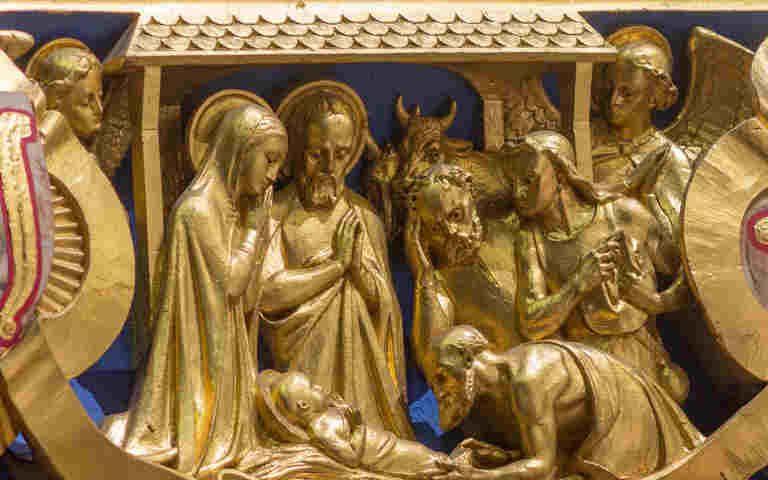The Abbey at Advent
The Reverend Mark Birch and writer Chine McDonald tell us what this holiest of seasons means to them.
3 minute read
![]()
The Reverend Mark Birch, Canon Rector, Westminster Abbey
If I were to try to sum up Advent in one word, it would have to be ‘bracing’. The main themes of this short season could hardly be more epic: death, judgement, afterlife, and the promise of Christ’s return. This season is the beginning of the Church year. We begin by contemplating our end.
If that weren’t enough to be thinking about, it is also the season during which the Abbey is making all its preparations for Christmas. Indeed, some Christmas services start to happen in the first week of Advent. It is therefore bracing, both spiritually and physically, and also rather confusing to keep bouncing between the austere themes of Advent on one hand, and the joy and wonder of Christmas on the other. Many clergy, in particular, lament how hard it is to focus on Advent, when Christmas and its demands seem to start earlier and earlier. While we are trying to think seriously about our mortality, someone will be running towards us in a Santa hat, waving a cracker, wondering why we are looking so serious.
'The light shines in the darkness'
Don't get me wrong, I love Christmas (although services at midnight have never been ideal for someone who likes to be in bed by 9.30pm), but I love it because it emerges out of Advent. ‘The light shines in the darkness’, as the Christmas gospel tells us. We need dark skies to see distant stars properly. It is good if we can wait a bit before turning on the fairy-lights, so that our eyes can appreciate the power of even the tiniest light.
In the face of the enormous themes of Advent, and the inevitable anxieties that emerge when we give serious thought to death and judgement (and what might follow) God presents us at Christmas with something small, vital, and vulnerable. Nothing can distract us quite like a new-born child. But the birth we celebrate at Christmas is not just to give us a break from the darkness of the world, or even just the dullness of our daily lives. This birth is given to us by way of an answer; an answer to the darkness, and to the fear it generates within us.
Before Jesus comes to be our judge, he comes to be with us (Emmanuel), as one of us. He comes small; a tiny scrap of life, in which, if we look carefully, we see a glimmer of our own origin and destiny.
When the services of Christmas Day are over, and all the bracing spiritual and physical demands of Advent are done, there is usually, for me, a precious moment of relief. It is the moment when I look in the Crib and see that he is there – tiny and vulnerable, but present. Here is God’s answer to the darkness in the world and in me. I don’t pretend to understand this answer fully, but it makes death seem less powerful, and judgement more merciful, and our prospects beyond this life more hopeful and glorious.
The Reverend Mark Birch is a Canon of Westminster
Chine McDonald, writer and broadcaster
There is no better example than Christmas to challenge the assumption that we live in a post-Christian society. As historian Tom Holland says, people in the West, who might believe they have freed themselves from religious belief, are like goldfish 'swimming in Christian waters'.
Even as fewer believe in God, and more disaffiliate from churches, the nativity scenes and carols found in churches and cathedrals at Christmas around the country keep people connected to a sense of ritual, rite of passage and nostalgia that the retellings of the Christian story can provide. For many who are drawn to the culturally pervasive Christmas story and seek a sense of the transcendent at Christmas, but lack the knowledge of what that might mean, cathedrals offer a space to reflect and experience a sense of the numinous.
A unique place in the cultural landscape
For those who seek – and even those who do not – cathedrals occupy a unique place within the cultural landscape of cities. For some, despite their grandeur, they seem more accessible than a local parish church where anonymity and space might not be afforded. Cathedrals also offer an element of surprise. In our report Spiritual Capital at Theos over a decade ago, we found that a third of people see cathedrals in general as ‘easy places to get in touch with the spiritual’, while just 17 per cent did not. When it came to people speaking about their local cathedrals, 95 per cent felt their particular one provided ‘a space where people can get in touch with the spiritual and the sacred’.
What was more surprising was that 72 per cent of those who were non-religious also felt that this was true. Some 88 per cent of people in the local survey found that the cathedral was ‘a place of sanctuary irrespective of what you believe’.
In the report, one person described the experience of taking an atheist friend from Germany to a cathedral during his visit at Christmas. At the end of the week his friend told him ‘I don’t believe in God, but I now believe there could be one’. The interviewee commented, ‘it is (a) power of the building we must not underestimate’.
In the years since we released our Spiritual Capital report, the nation and the world have been through tumultuous change. In 2022, the Collins Dictionary’s word of the year was ‘permacrisis’. There is a sense that the instability of Brexit, the rise of populism, a global pandemic, cost of living crisis and political turmoil have unsettled many. Within that turbulence, cathedrals offer a sense of stability, vastness and awe for visitors; refuge from the chaos of the world outside their walls.
This is perhaps being borne out in visitor numbers, with the Association of English Cathedrals’ figures showing a strong return towards pre-pandemic levels. Historic events at the Abbey over the past few years such as the Platinum Jubilee, the death and mourning period for Queen Elizabeth II, and The Coronation of Their Majesties The King and Queen opened up the nature and function of cathedrals to many.
It is likely that this Christmas, following these national events and the sense of societal turbulence, visitor numbers to cathedrals will increase even more.
Chine McDonald is director of Christian think-tank Theos and the author of ‘God is Not a White Man’ and ‘Am I Beautiful?’
This article was originally published in the Abbey Review, an annual magazine which delves into our 1,000-year history and explores life behind the scenes here at the Abbey today.
At different times of the day, or in different seasons, the light falling in the Abbey will light up something that you have walked past a million times and never seen before.
![]()













